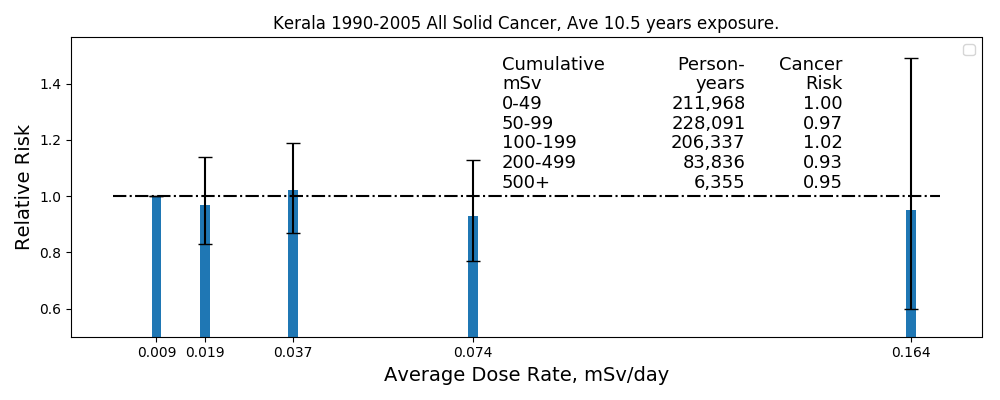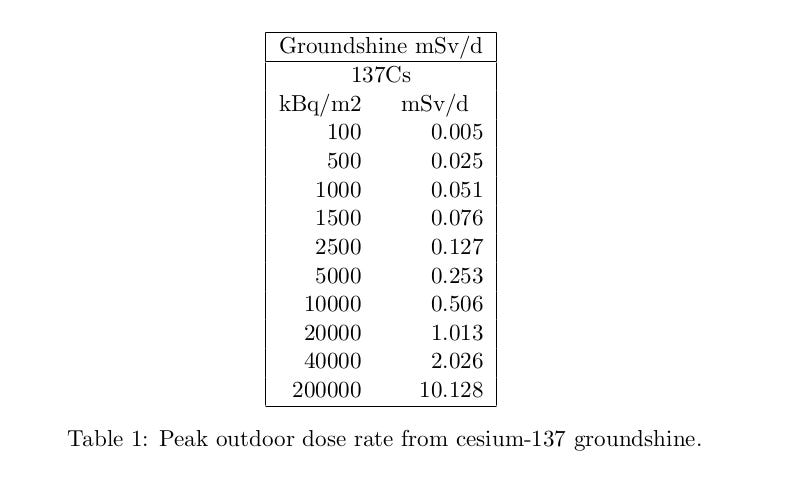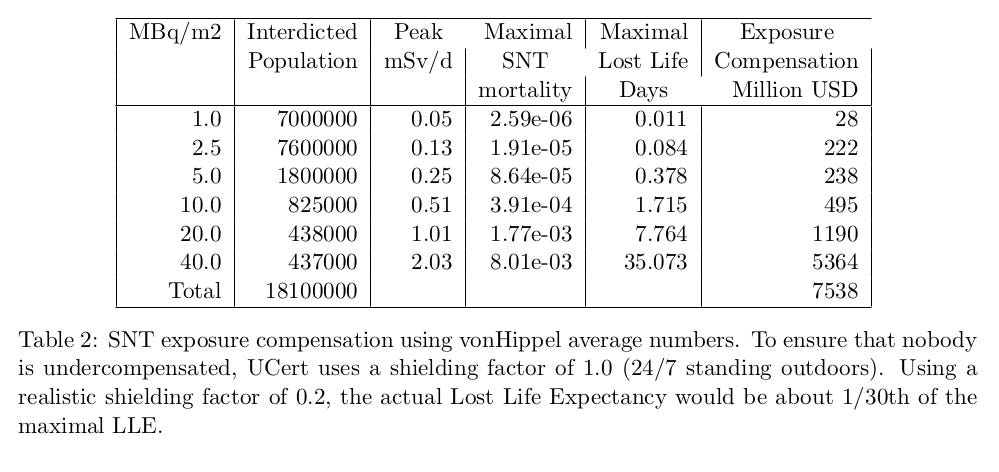This post assumes you are familiar with both the LNT and SNT models of radiation harm. You should also have read the post on dense-packing of spent fuel pools. A final prerequisite is some knowledge of Underwriter Certification (UCert) of nuclear power.
Figure 1. Cesium-137 ground contamination from a postulated dense-packed spent fuel pool fire at the Peach Bottom plant north of Baltimore. The figure shows four different weather patterns.\cite{vonhippel-2016} The red area would have to be evacuated under EPA recommendations. This would be a tragedy of epic proportions. 1.0 MBq/m2 is far below the levels at which there will be any detectable harm.
In 1990, four years after Chernobyl, after everything had calmed down, 220,000 people were uprooted from all areas in the USSR that had a cesium-137 contamination above 550 kBq/m2. Cesium-137 emits highly penetrating photon radiation. 550 kBq/m2 means 550,000 high energy photons are blasting off the ground every second from each square meter of land. This is called groundshine and it sounds pretty scary.
But the dose rate associated with standing on 550 kBq/m2 land is 0.028 mSv/d. That's a factor of 70 below the pre-1950 tolerance dose rate. We have never reliably detected an increase in cancers below about 20 mSv/day, even when that dose rate is suffered for decade or more, for example, the radium dial painters. Roughly half the people living in the Karunagappally district of India experience a dose rate higher than 0.028 all their lives, some as much as ten times higher. The high end Karunagappallians have a slightly lower cancer rate than the low end, Figure 2. The average background dose rate in South Dakota is 0.026 mSv/d, Figure 3}.
Figure 2. Cancer incidence in the Karunagappally population.
Figure 3. Average background dose rates for a sample of US states.
Why then did this cruel, stupid evacuation occur? The three letter answer is LNT. LNT is the radiation harm theory that claims the only thing that counts is cumulative dose. It does not matter how rapidly or slowly that dose is received. LNT denies our ability to repair radiation damage. The harm just keeps building up. In fact, we have extremely effective repair processes. As long as the dose rate is below 20 mSv/day, those processes repair the damage as fast as it occurs. Much above 20 mSv/d, the repair processes start to be overwhelmed.
Cesium-137 groundshine creates exactly the kind of dose rate profile that LNT screws up the worst. Cesium-137 has a half-life of 30 years. This means 30 years after the deposition, the dose rate will have dropped by only a factor or 2. The elevated dose rate will last a lifetime.
In the Chernobyl case, if a child continued to live on 550 kBq/m2 contaminated land for 70 years, he would receive a cumulative lifetime dose of 100 mSv. If 100 mSv is received all at once (acutely), we would expect about a 1% increase in cancer incidence. LNT says there is no difference between 100 mSv received all at once and 100 mSv received more or less evenly over 70 years. The powers that be followed LNT, and decreed that risk was unacceptable. The kid and his parents and his grandparents were kicked off their farm, and tossed into an urban environment for which they were not prepared. It was not all bad. They were allowed home once a year to tend the family graves.
If the authorities had used Sigmoid No Threshold (SNT), a radiation harm model that is more conservative than LNT on large acute doses; but does recognize our ability to repair radiation damage, the increase in the boy's lifetime cancer incidence would be 0.00007%. His Lost Life Expectancy would be 4.5 minutes. A rational, caring authority would inform the family of this risk and let them decide whether to move. Of course, this tragedy played out in a corrupt, authoritarian political environment. It could not happen in America.
Wrong. It would be worse. Recently, we talked about spent fuel pool fires. I don't know what the probability of a spent fuel pool fire is. Nobody does. I only know that it is far higher for a dense-packed pool than for an open-racked pool. I only know that the release will be far larger for a dense-packed pool than for an open-racked pool. I know open-racking would add less than 2% to the wholesale cost of nuclear power. Despite this, all US spent fuel pools are dense-packed.
Figure 1 shows the Cesium-137 contamination from a postulated spent fuel pool fire from the Peach Bottom plant north of Baltimore.\cite{vonhippel-2016} The authors, vonHippel and Schoeppner, assumed a 1600 PBq release over 32 hours. This was based on the average of dense-packed releases in a number of NRC studies. 1600 PBq is 12 times larger than the cesium release at Chernobyl.1 They used NOAA's HYSPLIT model to estimate the deposition pattern. HYSPLIT takes as input actual weather patterns, a big improvement over NRC's Gaussian plume model. They ran dozens of patterns. The four shown represent:
1) the lowest impact,
2) largest long range impact
3) most people relocated,
4) largest area evacuated.
The worst case release assumptions strike me as conservative but not unreasonably so. The plume modelling is state of the art. Where the authors went off the rails is they accepted LNT. LNT leads to the EPA recommendation to relocate if the first year dose is more than 20 mSv or subsequent annual dose are more than 5 mSv (0.014 mSv/d). (The EPA recommendation would have us evacuate 8 states, Figure 3.) This leads to evacuating all areas that are above 1000 kBq/m2 for a very long time. This is called the interdiction level. In these runs, an interdiction level of 1000 kBq/m2 resulted in the relocation of 7 to 41 million people with an average of 18 million. In other words, chaos.
But what counts is the dose rate. Table 1 shows that, at 1000 kBq/m2, the dose rate is 0.05 mSv/day. That's 40 times less than the pre-1950 tolerance dose rate. And to receive that daily dose, you would have to stand outside on open ground for the entire 24 hours. After Fukushima, the citizens of Date-shi, a town just outside the evacuation area, were issued dosimeters. The average dose rates measured by the dosimeters were 0.15+/-0.03 of the outside ambient dose rates.\cite{ishikawa-2015} The NRC calls this the shielding factor.
Assuming you stood outside 24/7, you would need a Cesium-137 contamination of 40,000 kBq/m2 to receive 2 mSv/d. If we assume a shielding factor of 0.20, then we would need a contamination of 200,000 kBq/m2 to reach the 2 mSv/d tolerance dose rate. and we are still a factor of ten below dose rates where we have reliably seen an increase in cancer. The red area in Figure 1 is tragically misleading. In order to see any detectable harm, we need cesium-137 contamination levels far above 1000 kBq/m2. If the EPA rules are followed, practically all the harm will result from the evacuation, not the radiation exposure. Tragically, we can be quite confident that under the current system something like the EPA rules will be imposed.
How would Underwriter Certification handle this?
In an ideal world, nuclear power would be regulated by Underwriter Certification. How would Underwriter Certification handle this sort of release? Unfortunately, vonHippel and Schoeppner do not show us any contours for contamination above 1000 kBq/m2, which we would need to estimate the UCert compensation. But a table in the paper does go up to 5000 kBq/m2. It shows a roughly linear dependence between interdiction level and people relocated. If we heroicly assume doubling the dose rate halves the population exposed to that dose rate, we can ballpark the compensation.
Table 2 shows some results based on the average of the vonHippel runs. The radiation exposure compensation is 7.5 billion dollars. The compensation is sharply focused on the hardest hit areas due to the highly non-linear nature of SNT. Based on our study of Fukushima, we can expect the lost earnings compensation to be roughly three times the exposure compensation. We are talking something north of 20 billion dollars total. Using vonHippel and Schoeppner's high end numbers, would double this. This is for a Chernobyl sized release that is handled perfectly. Even if the US adopted Underwriter Certification, I doubt this event is insurable. The obvious solution is open-racking.
Nuclear needs to be both smart about potential harm and cheap. We are stupid and expensive. Not a good combination.
At Chernobyl, we also had a release of 1760 PBq of I-131, and 1150 PBq of Te-132. These short lived isotopes will not be a factor in a spent fuel release.







I'm wondering why you reference and indirectly give bandwidth the UCS fearmongers? Rod Adams wrote a good rebuttal on June 20, 2017 to their extreme opinions opposing an aspect of nuclear power generation here: https://atomicinsights.com/spent-fuel-pools-protect-public-dont-believe-skeptics/ Please note the NRC conclusions based on extensive research and analysis that are found in Rod's article.
Periodically, the local fearmongers have raised this issue at Diablo Canyon Power Plant near San Luis Obispo, California.
As you say, the NLT figment of harmful radiation to the general public has squandered a phenomenal amount of western money building a needless sarcophagus, When fear rules, money flows.